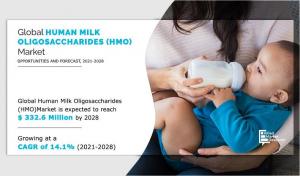Human Milk Oligosaccharides (HMO) Market infographic
Infant Nutrition Soars: The HMO Market Booms!
— Allied Market Research
WILMINGTON,NEW CASTLE, DELAWARE, UNITED STATES, April 24, 2024 /EINPresswire.com/ — According to a new report published by Allied Market Research, titled, “Human Milk Oligosaccharides (HMOs) Market by Type, Application, and Distribution Channel: Global Opportunity Analysis and Industry Forecast, 2021–2028,”the global human milk oligosaccharides (HMO) market size was valued at $125.9 million in 2020, and is estimated to reach $332.6 million by 2028, registering a CAGR of 14.1% from 2021 to 2028.
𝐀𝐯𝐚𝐢𝐥𝐚𝐛𝐥𝐞 𝐒𝐚𝐦𝐩𝐥𝐞 𝐑𝐞𝐩𝐨𝐫𝐭 𝐰𝐢𝐭𝐡 𝐆𝐫𝐚𝐩𝐡𝐬 𝐚𝐧𝐝 𝐅𝐢𝐠𝐮𝐫𝐞𝐬 @
Human milk oligosaccharide (HMO) is a prebiotic that aids in the maintenance of human gut health. It stimulates bacterial growth, particularly in the Bifidobacteriagenus, which aids in metabolic activity. Owing to its antimicrobial and prebiotic properties, it can be used in a variety of foods, including pharmaceutical and medicinal foods as well as infant formulas.
HMOs are sugars, which are the third most abundant solid nutrients in human breast milk after lactose and fats. They improve and enhance infant health by promoting immune development, neurodevelopment, and digestion, and also have the potential to benefit adults. Some of the nutritional effects of HMOs found in human milk can be recreated by commercially manufactured HMOs.
𝐌𝐚𝐫𝐤𝐞𝐭 𝐃𝐲𝐧𝐚𝐦𝐢𝐜𝐬 𝐨𝐟 𝐇𝐮𝐦𝐚𝐧 𝐌𝐢𝐥𝐤 𝐎𝐥𝐢𝐠𝐨𝐬𝐚𝐜𝐜𝐡𝐚𝐫𝐢𝐝𝐞𝐬 (𝐇𝐌𝐎)
𝐃𝐫𝐢𝐯𝐞𝐫𝐬: 𝐑𝐢𝐬𝐞 𝐢𝐧 𝐈𝐧𝐟𝐚𝐧𝐭 𝐏𝐨𝐩𝐮𝐥𝐚𝐭𝐢𝐨𝐧
The global birth rate, as indicated by UN data, underscores a significant and continuous increase in the infant population, with over 250 babies born per minute worldwide. This surge in births, totaling over 130 million annually, directly correlates with heightened consumption of infant formulas globally. Factors such as the rising number of working women post-birth, maternal lactation challenges, and evolving nutrition options for infants contribute to increased demand. Projections suggest a global population of 9.6 billion by 2050, further propelling the demand for HMOs in infant nutrition, with China emerging as a pivotal market due to its substantial birth rates.
𝐑𝐞𝐬𝐭𝐫𝐚𝐢𝐧𝐭𝐬: 𝐇𝐢𝐠𝐡 𝐏𝐫𝐨𝐝𝐮𝐜𝐭𝐢𝐨𝐧 𝐂𝐨𝐬𝐭𝐬
The complexity, expense, and uncertainty surrounding the development and commercialization of HMO products pose significant challenges. Product success hinges on technological advancements, consumer demand, and regulatory compliance. Substantial investment is necessary for R&D, production, and compliance with international food regulations. High production costs translate into elevated product prices, further compounded by marketing and distribution expenses, constraining market growth.
𝐎𝐩𝐩𝐨𝐫𝐭𝐮𝐧𝐢𝐭𝐢𝐞𝐬: 𝐄𝐦𝐞𝐫𝐠𝐞𝐧𝐜𝐞 𝐨𝐟 𝐀𝐥𝐭𝐞𝐫𝐧𝐚𝐭𝐢𝐯𝐞 𝐀𝐧𝐢𝐦𝐚𝐥 𝐌𝐢𝐥𝐤 𝐎𝐥𝐢𝐠𝐨𝐬𝐚𝐜𝐜𝐡𝐚𝐫𝐢𝐝𝐞𝐬
The advent of alternative sources of animal milk oligosaccharides presents lucrative opportunities in infant nutrition. Bovine and goat milk-based oligosaccharides, demonstrated to have prebiotic properties similar to breast milk, are poised to gain traction in the market. Brands like Kabrita offer goat milk-based infant formulas, while camel milk-based baby formulas, rich in iron, are also gaining popularity. These animal-derived oligosaccharides are anticipated to find increasing acceptance in the infant formula ingredients market, diversifying nutritional options for infants.
𝐂𝐡𝐚𝐥𝐥𝐞𝐧𝐠𝐞𝐬: 𝐂𝐨𝐦𝐩𝐥𝐞𝐱 𝐈𝐧𝐝𝐮𝐬𝐭𝐫𝐢𝐚𝐥 𝐄𝐱𝐭𝐫𝐚𝐜𝐭𝐢𝐨𝐧 𝐏𝐫𝐨𝐜𝐞𝐬𝐬𝐞𝐬
The industrial extraction of oligosaccharides from mammalian milk poses significant challenges, primarily concerning purity and product recovery. Achieving high purity while eliminating simple sugars like lactose, glucose, and galactose, which lack prebiotic properties, necessitates advanced extraction techniques. While techniques like lactose hydrolysis combined with membrane filtration have shown promise, there is a need for further research and development to streamline extraction processes and enhance product purity.
𝐈𝐧𝐭𝐞𝐫𝐞𝐬𝐭𝐞𝐝 𝐭𝐨 𝐏𝐫𝐨𝐜𝐮𝐫𝐞 𝐭𝐡𝐞 𝐃𝐚𝐭𝐚 𝐈𝐧𝐪𝐮𝐢𝐫𝐞 @
Fermented HMO allows infant formula manufacturers to produce formula that is more similar to human milk than ever before, allowing formula-fed babies to benefit from these important components of breast milk. Human milk oligosaccharides serve a variety of primary functions, including infection prevention, prebiotic effects, and sialic acid supply for brain growth. Infant formula made from bovine milk, that is cow milk, contains less oligosaccharides than human milk. Ash MOs are beneficial to the micro biome and immunity, key players are researching and developing new techniques, such as extracting HMO from cow milk using expensive techniques, or even generating them using microbes.
The rapid evolution of consumer preferences is one of the key factors driving innovation in the food & beverage industry. At present, the current Human Milk Oligosaccharides (HMO) market trends indicate that the demand for HMOs is expected to grow at a significant rate in the coming years, due to the steady rise in number of health-conscious people around the world as well as increase in awareness about the benefits of HMOs. Owing to rise in customer concerns about stable health and increase in the use of food supplements or dietary supplements, the Human Milk Oligosaccharides (HMO) market has witnessed exponential growth.
Furthermore, over the last decade, a large number of players have gradually entered the global Human Milk Oligosaccharides (HMO) market, resulting in the availability of HMOs with a wide range of nutritional content through a variety of distribution channels. Another factor that has contributed to the popularity of HMOs in recent years is the digital boom, which has seen brands continue to promote their products via online sales channels such as e-mail marketing, social media, and newsletters. While the global Human Milk Oligosaccharides (HMO) market remains competitive, market participants are expected to concentrate on packaging, pricing, and marketing strategies to gain a competitive advantage in the current market landscape.
The Human Milk Oligosaccharides (HMO) market segmentation is done on the basis of type, application, distribution channel, and region. By type, the market is categorized into2’FL, 3’FL, 3’SL, and 6’SL. The applications covered in the study include infant formula, functional food & beverage, and food supplements. According to distribution channel, the Human Milk Oligosaccharides (HMO )market is fragmented into hypermarkets & supermarkets, drug store or pharmacy, mass merchandiser, departmental stores, mono-brand stores, specialty stores, and online sales channel. Regionwise, it is analyzed across North America, Europe, Asia-Pacific, and LAMEA. In this way, Human Milk Oligosaccharides (HMO) market analysis is done.
By type, the 2’FLsegment was the highest revenue contributor in 2020,due to the fact that the ability of 2’FL is to protect against infectious diseases by preventing toxins and pathogens from adhering to epithelial cells is well noticeable. Depending on application, the infant formula segment held the largest Human Milk Oligosaccharides (HMO) market share, as HMOs’ beneficial properties such as memory formation and cognitive performance help in the growth and development of infants. As per distribution channel, the drug stores or pharmacy segment led the Human Milk Oligosaccharides (HMO) market. This is attributed to the fact that to drug store operators have emphasized convenience factors such as extended store hours and drive-through locations to attract and retain customers during increasing competition from mail-order retailers and supercenters.
Owing to global concerns about poor nutrition and premature death, the demand for HMO in infant formula is accelerating market growth. This is attributed to the fact that HMOsexhibit prebiotic properties, the potential to improve memory & brain growth, and a high nutritional value. This is also one of the Human Milk Oligosaccharides (HMO) market opportunity. The ability of breast milk to protect babies from infection and allergic reactions is expected to positively impact the market size, as human milk appears to provide long-term protection against obesity, hypertension, inflammation, diabetes, and heart disease in humans.
The introduction of new products is expected to reduce the impact of specific diseases such as diabetes and indigestion. Some major manufacturers have already started to offer products in specific health and wellness categories, such as digestion and cognitive enhancement. This trend is expected to take center stage and gain significant traction in the rapidly expanding functional food & beverage market, as well as significant brand equity, during the Human Milk Oligosaccharides (HMO) market forecast.
The third most abundant component of human milk is human oligosaccharides, which cannot be synthesized directly from human milk due to the donor group’s scarcity. Currently, manufacturers use chemical and enzyme synthesis to produce human milk oligosaccharides. These methods necessitate a large investment of time and money, but the end result is relatively small.
𝐆𝐞𝐭 𝐘𝐨𝐮𝐫 𝐑𝐞𝐩𝐨𝐫𝐭 𝐂𝐮𝐬𝐭𝐨𝐦𝐢𝐳𝐞𝐝 @
For example, expensive substrates such as glycosyl-transferases necessitate enzyme synthesis, which is one of the primary reasons for the high price of human milk oligosaccharides. Prebiotics, such as fructooligosaccharides and galactooligosaccharides, are used in infant formula to prevent the growth of pathogenic Escherichia coli bacteria. Consumption of these has been shown to improve infant gastrointestinal tract health by promoting the development of specific microorganisms in the intestinal micro flora. Infant formula manufacturers use these as a substitute for HMOs due to their low cost and widespread availability. As a result, these functionally equivalent alternatives to HMOs are severely limiting market growth.
In 2020, the outbreak of the COVID-19 pandemic had an impact on the global Human Milk Oligosaccharides (HMO) market growth. Retail stores, malls, supermarkets, and other sales channels have been closed as a result of stringent lockdown imposed by governments around the world. During the lockdown, however, several brands have shifted their focus to e-commerce platforms to generate revenue and increase sales. Offline sales are increasing currently, as government lockdown restrictions are gradually being lifted in a number of countries.
Product launches, mergers & acquisitions, joint ventures, and geographical expansions are the key strategies adopted by players in the Human Milk Oligosaccharides (HMO) industry. The key players operating in the Human Milk Oligosaccharides (HMO) industry include Abbott Laboratories, BASF S.E., Biosynth Carbosynth, Chr. Hansen Holding A/S, Dextra Laboratories Ltd., Dupont Nutrition & Biosciences, Elicityl S.A., Glycom A/S, Glycosyn, Inbiose NV, Medolac Laboratories, Neolacta Lifesciences Pvt. Ltd, Nestle Health Science, Royal DSM, and ZuChem.
𝐊𝐞𝐲 𝐟𝐢𝐧𝐝𝐢𝐧𝐠𝐬 𝐨𝐟 𝐭𝐡𝐞 𝐬𝐭𝐮𝐝𝐲
𝐓𝐡𝐞 𝐠𝐥𝐨𝐛𝐚𝐥 𝐇𝐮𝐦𝐚𝐧 𝐌𝐢𝐥𝐤 𝐎𝐥𝐢𝐠𝐨𝐬𝐚𝐜𝐜𝐡𝐚𝐫𝐢𝐝𝐞𝐬 (𝐇𝐌𝐎) 𝐦𝐚𝐫𝐤𝐞𝐭 𝐰𝐚𝐬 𝐯𝐚𝐥𝐮𝐞𝐝 𝐚𝐭 $𝟏𝟐𝟓.𝟗 𝐦𝐢𝐥𝐥𝐢𝐨𝐧 𝐢𝐧 𝟐𝟎𝟐𝟎, 𝐚𝐧𝐝 𝐢𝐬 𝐩𝐫𝐨𝐣𝐞𝐜𝐭𝐞𝐝 𝐭𝐨 𝐫𝐞𝐚𝐜𝐡 $𝟑𝟑𝟐.𝟔 𝐦𝐢𝐥𝐥𝐢𝐨𝐧 𝐛𝐲 𝟐𝟎𝟐𝟖, 𝐫𝐞𝐠𝐢𝐬𝐭𝐞𝐫𝐢𝐧𝐠 𝐚 𝐂𝐀𝐆𝐑 𝐨𝐟 𝟏𝟒.𝟏% 𝐟𝐫𝐨𝐦 𝟐𝟎𝟐𝟏 𝐭𝐨 𝟐𝟎𝟐𝟖.
𝐄𝐮𝐫𝐨𝐩𝐞 𝐰𝐚𝐬 𝐭𝐡𝐞 𝐡𝐢𝐠𝐡𝐞𝐬𝐭 𝐫𝐞𝐯𝐞𝐧𝐮𝐞 𝐜𝐨𝐧𝐭𝐫𝐢𝐛𝐮𝐭𝐨𝐫, 𝐚𝐜𝐜𝐨𝐮𝐧𝐭𝐢𝐧𝐠 𝐟𝐨𝐫 $𝟒𝟓.𝟑 𝐦𝐢𝐥𝐥𝐢𝐨𝐧 𝐢𝐧 𝟐𝟎𝟐𝟎, 𝐚𝐧𝐝 𝐢𝐬 𝐞𝐬𝐭𝐢𝐦𝐚𝐭𝐞𝐝 𝐭𝐨 𝐫𝐞𝐚𝐜𝐡 $𝟏𝟐𝟒.𝟏 𝐦𝐢𝐥𝐥𝐢𝐨𝐧 𝐛𝐲 𝟐𝟎𝟐𝟖, 𝐰𝐢𝐭𝐡 𝐚 𝐂𝐀𝐆𝐑 𝐨𝐟 𝟏𝟒.𝟔%.
𝐁𝐲 𝐭𝐲𝐩𝐞, 𝐭𝐡𝐞 𝟐’𝐅𝐋 𝐬𝐞𝐠𝐦𝐞𝐧𝐭 𝐰𝐚𝐬 𝐭𝐡𝐞 𝐡𝐢𝐠𝐡𝐞𝐬𝐭 𝐜𝐨𝐧𝐭𝐫𝐢𝐛𝐮𝐭𝐨𝐫 𝐭𝐨 𝐭𝐡𝐞 𝐦𝐚𝐫𝐤𝐞𝐭, 𝐰𝐢𝐭𝐡 $𝟒𝟐.𝟑 𝐦𝐢𝐥𝐥𝐢𝐨𝐧 𝐢𝐧 𝟐𝟎𝟐𝟎, 𝐚𝐧𝐝 𝐢𝐬 𝐞𝐬𝐭𝐢𝐦𝐚𝐭𝐞𝐝 𝐭𝐨 𝐫𝐞𝐚𝐜𝐡 $𝟏𝟐𝟎.𝟔 𝐦𝐢𝐥𝐥𝐢𝐨𝐧 𝐛𝐲 𝟐𝟎𝟐𝟖, 𝐚𝐭 𝐚 𝐂𝐀𝐆𝐑 𝐨𝐟 𝟏𝟒.𝟔% 𝐝𝐮𝐫𝐢𝐧𝐠 𝐭𝐡𝐞 𝐟𝐨𝐫𝐞𝐜𝐚𝐬𝐭 𝐩𝐞𝐫𝐢𝐨𝐝.
𝐎𝐧 𝐭𝐡𝐞 𝐛𝐚𝐬𝐢𝐬 𝐨𝐟 𝐚𝐩𝐩𝐥𝐢𝐜𝐚𝐭𝐢𝐨𝐧, 𝐭𝐡𝐞 𝐢𝐧𝐟𝐚𝐧𝐭 𝐟𝐨𝐫𝐦𝐮𝐥𝐚 𝐬𝐞𝐠𝐦𝐞𝐧𝐭 𝐰𝐚𝐬 𝐭𝐡𝐞 𝐡𝐢𝐠𝐡𝐞𝐬𝐭 𝐜𝐨𝐧𝐭𝐫𝐢𝐛𝐮𝐭𝐨𝐫 𝐭𝐨 𝐭𝐡𝐞 𝐦𝐚𝐫𝐤𝐞𝐭, 𝐰𝐢𝐭𝐡 $𝟔𝟕.𝟗 𝐦𝐢𝐥𝐥𝐢𝐨𝐧 𝐢𝐧 𝟐𝟎𝟐𝟎, 𝐚𝐧𝐝 𝐢𝐬 𝐞𝐬𝐭𝐢𝐦𝐚𝐭𝐞𝐝 𝐭𝐨 𝐫𝐞𝐚𝐜𝐡 $𝟏𝟗𝟏.𝟕 𝐦𝐢𝐥𝐥𝐢𝐨𝐧 𝐛𝐲 𝟐𝟎𝟐𝟖, 𝐚𝐭 𝐚 𝐂𝐀𝐆𝐑 𝐨𝐟 𝟏𝟒.𝟓% 𝐝𝐮𝐫𝐢𝐧𝐠 𝐭𝐡𝐞 𝐟𝐨𝐫𝐞𝐜𝐚𝐬𝐭 𝐩𝐞𝐫𝐢𝐨𝐝.
𝐈𝐧 𝐄𝐮𝐫𝐨𝐩𝐞, 𝐭𝐡𝐞 𝐔𝐊 𝐰𝐚𝐬 𝐭𝐡𝐞 𝐡𝐢𝐠𝐡𝐞𝐬𝐭 𝐫𝐞𝐯𝐞𝐧𝐮𝐞 𝐜𝐨𝐧𝐭𝐫𝐢𝐛𝐮𝐭𝐨𝐫 𝐰𝐢𝐭𝐡 $𝟏𝟐.𝟓 𝐦𝐢𝐥𝐥𝐢𝐨𝐧 𝐢𝐧 𝟐𝟎𝟐𝟎, 𝐚𝐧𝐝 𝐢𝐬 𝐞𝐬𝐭𝐢𝐦𝐚𝐭𝐞𝐝 𝐭𝐨 𝐫𝐞𝐚𝐜𝐡 $𝟑𝟕.𝟓 𝐌𝐢𝐥𝐥𝐢𝐨𝐧 𝐛𝐲 𝟐𝟎𝟐𝟖, 𝐫𝐞𝐠𝐢𝐬𝐭𝐞𝐫𝐢𝐧𝐠 𝐚 𝐂𝐀𝐆𝐑 𝐨𝐟 𝟏𝟓.𝟒%.
𝐀𝐛𝐨𝐮𝐭 𝐔𝐬
Allied Market Research (AMR) is a full-service market research and business-consulting wing of Allied Analytics LLP, based in Portland, Oregon. Allied Market Research provides global enterprises as well as medium and small businesses with unmatched quality of “Market Research Reports” and “Business Intelligence Solutions.” AMR has a targeted view of providing business insights and consulting to assist its clients in making strategic business decisions and achieving sustainable growth in their respective market domain.
We have professional corporate relations with various companies and this helps us dig out market data that helps us generate accurate research data tables and confirms utmost accuracy in our market forecasting. Allied Market Research CEO Pawan Kumar is instrumental in inspiring and encouraging everyone associated with the company to maintain high-quality of data and help clients in every way possible to achieve success. Each and every piece of data presented in the reports published by us is extracted through primary interviews with top officials from leading companies in domain concerned. Our secondary data procurement methodology includes deep online and offline research and discussion with knowledgeable professionals and analysts in the industry.
David Correa
Allied Market Research
+1 503-894-6022
email us here
Visit us on social media:
Facebook
Twitter
LinkedIn
Other
![]()
Article originally published on www.einpresswire.com as Infant Nutrition & Health Drive Growth




